Ever since I inherited this lovely camera, I’ve wanted to treat it to some black-and-white. But I waited until I had some successful trials with Caffenol under my belt (like this one).
A Little History
“Ansco” is short for “Anthony and Scovill”… a Binghampton, NY amateur photography supplier that Eastman Kodak nearly put out of business. Then, according to the company’s Wiki, in 1928:
“Agfa of Germany merged with Ansco and allowed it to compete in the worldwide photographic market like its competitors, Kodak and Zeiss. This joint company added many Agfa cameras and accessories to its sales in the USA… In the months after the bombing of Pearl Harbor, the US Government seized Agfa-Ansco. This now government-run business continued to survive as a hostile alien property (under government control into the 1960s)… The organization was renamed GAF (General Aniline & Film Corporation)… The concern sold rebadged versions of cameras made by other manufacturers, including Agfa and Chinon. A Minolta-built Ansco model was the first 35mm camera in outer space, and their film was used in space, too.”
A Sterling Reputation
My first clue about the Super Memar’s reputation came in the book “Collecting and Using Classic Cameras.” There, British author, photographer and collector Ivor Matanle called the Super Memar’s original Agfa version “a considerable find… with tremendous potential for quiet and unobtrusive available-light photography.”
He was describing the highest-spec version of the Memar camera line– the one with a 6-element 50mm f/2.0 Solagon lens and a Synchro-Compur shutter topping out at 1/500 second. My camera is Ansco’s American version, and it also happens to be the easiest camera I’ve owned for doing manual “Sunny-16” metering.
With a Few Small Flaws
The Super Memar is a bit of a hidden gem actually– looking like many other inexpensive 1950’s rangefinders. Parts of it seem to have been made rather cheaply though:
- Its finish reportedly wears quickly (though my camera’s is almost store-new).
- The rewind knob rotates in both directions too easily, which could spawn film-flatness issues (I’ll discuss this later).
- And like many cameras of its time, the L-M flash-sync control also includes a V self-timer (though the spring in my camera’s mechanism is now too weak to work).
But the Super Memar more than makes up for these in other areas:
- Unlike most less-expensive rangefinders of its day, it’s built like a tank (and almost as heavy as my Zeiss Ikon Contaflex Super B SLR).
- Its fit and finish seem more streamlined and elegant than the original Agfa Super Silette’s. The Super Memar, for example, has a more finger-friendly, semi-circular, knurled focusing lever.
- The winding lever is sturdy and well damped.
- The viewfinder is clear and bright, with an easy-to-use split-image focusing area. But one can also turn the camera into a two-zone fixed-focus device (described later).
- Its shutter button presses smoothly and gently and the shutter is extremely quiet.
- An extendable foot in the front of the base plate keeps the heavy f/2 lens from tipping the camera over.
- The Solagon lens is reportedly great. Its front group also unscrews on buttery-smooth brass threads (which makes it easy to clean the glass and the shutter behind it).
- And like many vintage Light-Value-System cameras, its aperture and shutter-speed rings interlock (making it dead easy to select equivalent alternate settings for a specific exposure… as described next).
Super-Easy Exposure Settings
The feature in that last bullet seems unpopular with users of other LVS cameras. Apparently, some implementations are awkward and difficult to use. Not the Super Memar’s.
In the following photo, the first ring behind the lens front sets the shutter speed and the ring behind that, the aperture. Here, the camera is set to an exposure of 1/8 second @ f:8:
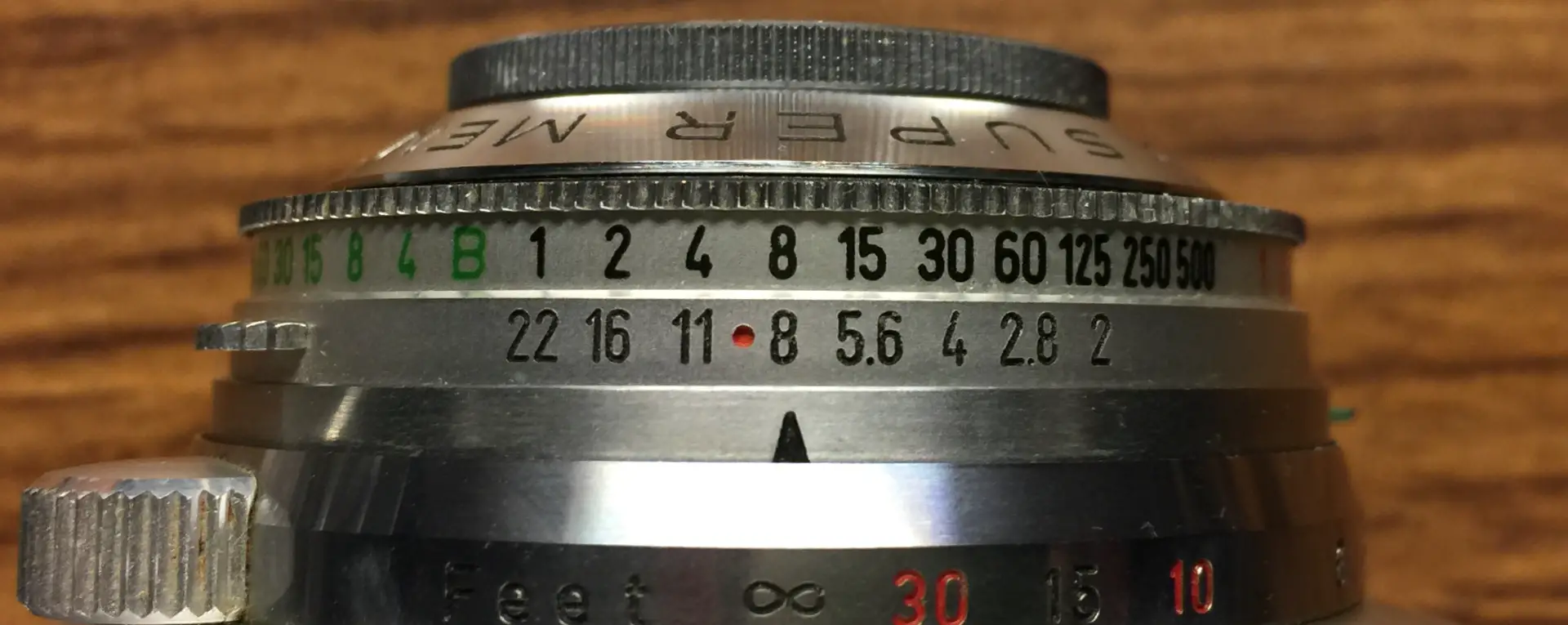 But since the rings automatically interlock, one can quickly select seven other equivalent exposures– from 1 second @ f:22 (for a long exposure with maximum depth-of-field) to 1/125 second @ f:2 (for a fast exposure with maximum subject-background separation). (A raised, knurled edge on the shutter-speed ring makes it easy to turn both linked rings together.)
But since the rings automatically interlock, one can quickly select seven other equivalent exposures– from 1 second @ f:22 (for a long exposure with maximum depth-of-field) to 1/125 second @ f:2 (for a fast exposure with maximum subject-background separation). (A raised, knurled edge on the shutter-speed ring makes it easy to turn both linked rings together.)
The extent of this available range will vary. In the following photo, for example, the camera is set to 1/125 second @ f/11. And the range of equivalent exposures is narrower– five options from 1/30 second @ f/22 to 1/500 second @ f/5.6:
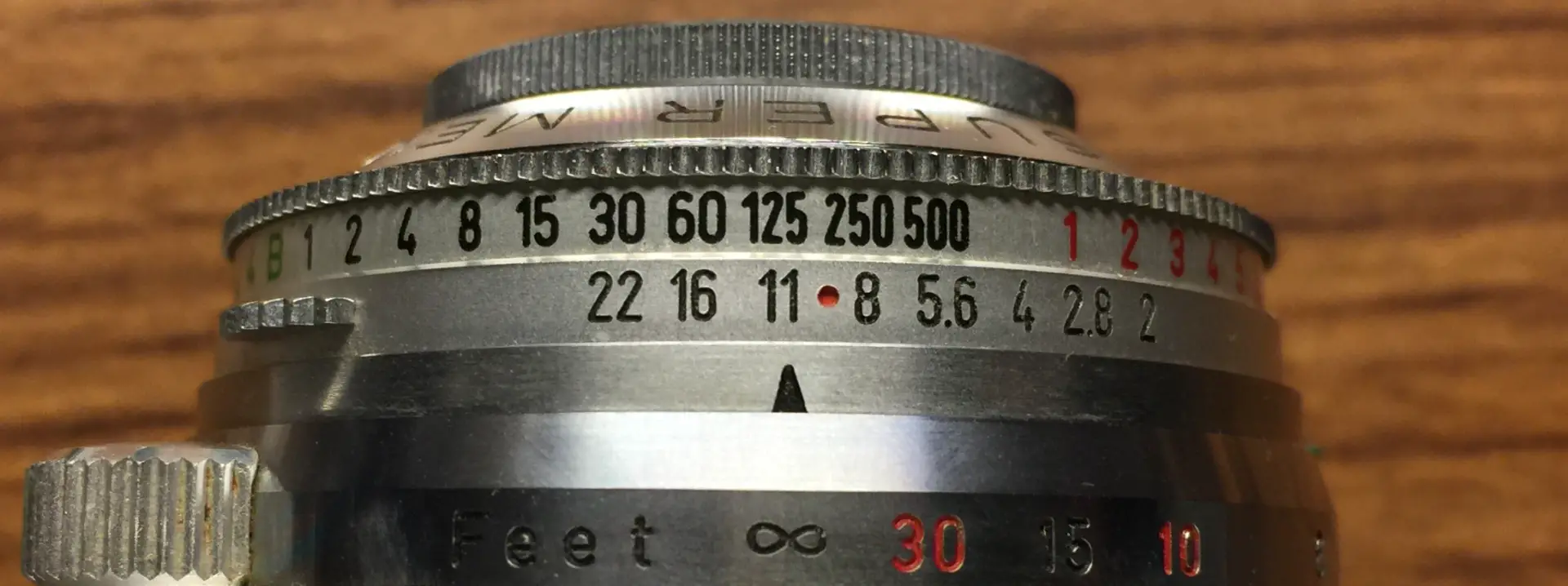 NOTE: While the Super Memar allows “half” apertures between the ones marked, it only permits the marked shutter speeds.
NOTE: While the Super Memar allows “half” apertures between the ones marked, it only permits the marked shutter speeds.
To set different aperture/shutter-speed combinations, pull the knurled tab that’s to the left of the f/22 mark toward you, turn the aperture ring until the desired aperture and speed line up, and then release the ring. It springs back in place, and again interlocks both rings. Easy peasy!
And Flexible Focusing Options
As mentioned above, the viewfinder is clear and bright, with an easy-to-use split-image focusing area.
But one can also turn the camera into a two-zone fixed-focus device as follows:
- Set the focusing ring to either 10 or 30 feet (seen marked in red in the above photo).
- Set the shutter speed to 1/60 sec and the aperture to the red dot between 11 and 8 (probably this lens’s “sweet spot”).
- With the focus ring set to 10 feet, everything between 7 and 15 feet will be in focus. And when set to 30 feet, everything from 15 feet to infinity will be in focus.
Though that procedure may sound complicated, it basically selects settings that should provide decently sharp images in most normal situations.
NOTE: Not counting a Kodak Flash Bantam 828-rollfilm camera that I converted to half-frame 35mm, I have ten 35mm cameras. And the three that support similar zone focusing are all of German design. As just described, the Super Memar supports two focusing zones (at 10 and 30 feet). The Kodak Retina 2a supports two as well (at 10 and 15 feet). And the Zeiss Ikon Contaflex Super B has just one (at 20 feet, with a depth-of-field at f/8 from 10 feet to infinity).
And for people familiar with Hyperfocal Focusing, a clear Depth-of-Field scale is conveniently engraved on top of the lens barrel, just behind the focusing ring. (It shows up better in this graphic from the user manual than it does in my photos of the camera’s curved, reflective surface):
 But What About the Pix?
But What About the Pix?
This all sounds grand… but what about that f/2 lens? As you’ll see, it acquits itself quite well in normal shooting conditions. But I first wanted to test the fast glass on some nighttime interior vignettes.
Here’s a primitive grain basket, lamp and two vases. I focused on the lamp’s corrugated-cardboard base– at a point about 1.5 inches higher than the tall vase’s rim:
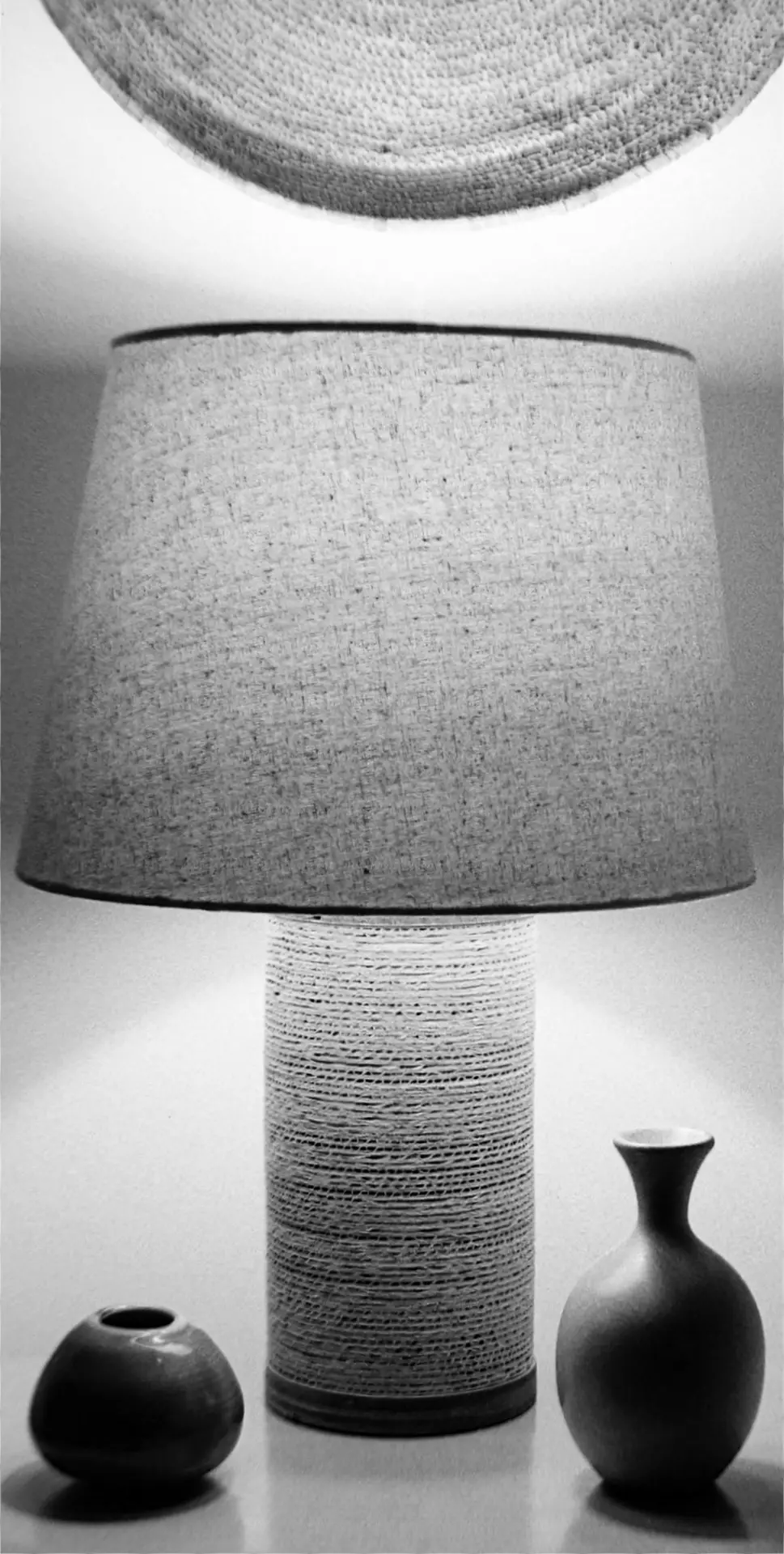
I next grabbed a still life of just those vases, with the lens wide open at f/2. The Super Memar doesn’t have a meter, so I estimated all of these interior exposures using a fast-lensed Olympus C-8080 WZ digicam. It was in Aperture-Priority mode, and for the next shot, let me open its f/2.4-3.5 lens to only f/3.6. So I guessed the equivalent exposure on the Super Memar– with its aperture open almost two stops wider— would be a shutter speed two times faster. And this resulted:
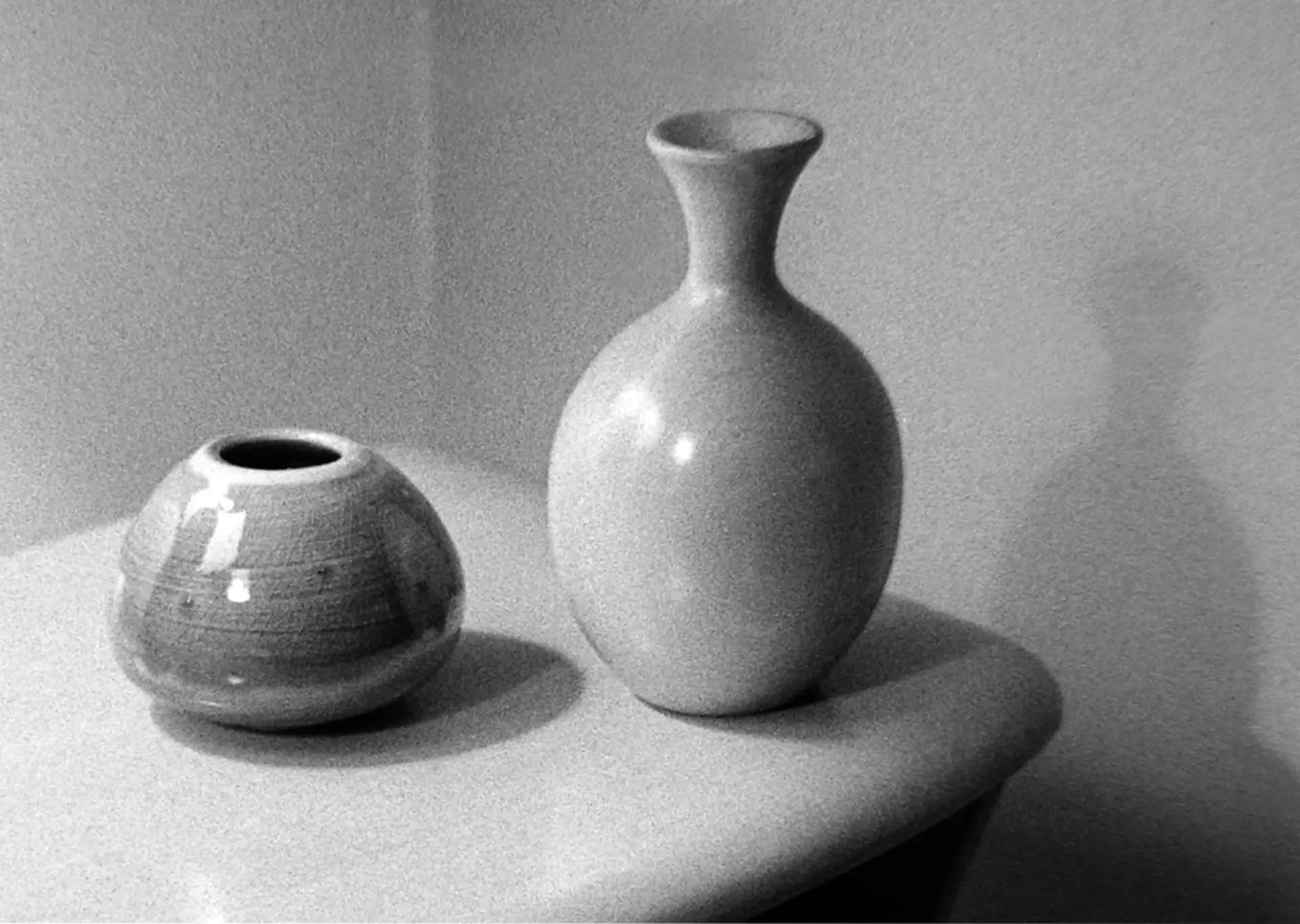
There may be two reasons for the enhanced grain:
- I could have overexposed the film. Kodak’s 5222 Double-X data sheet warns that this might magnify grain.
- And since the Super Memar’s closest-focus distance is 3.5 feet, I had to crop my scanned negative tightly to get the above desired framing. This “crop-zoom” magnified the grain even more.
Obviously, f/2 would be a good choice for “artfully soft” results in low light! And I do like the photo’s feel. But note: I had focused on the “craquelure” in the small vase’s glaze. And if you examine the above image closely, those fine cracks look like thin, nearly vertical “scratches” on the vase surface. Not too shabby resolution for split-image focusing, by lamplight, at f/2!
Next, a look-up shot of the stairs to our second floor:
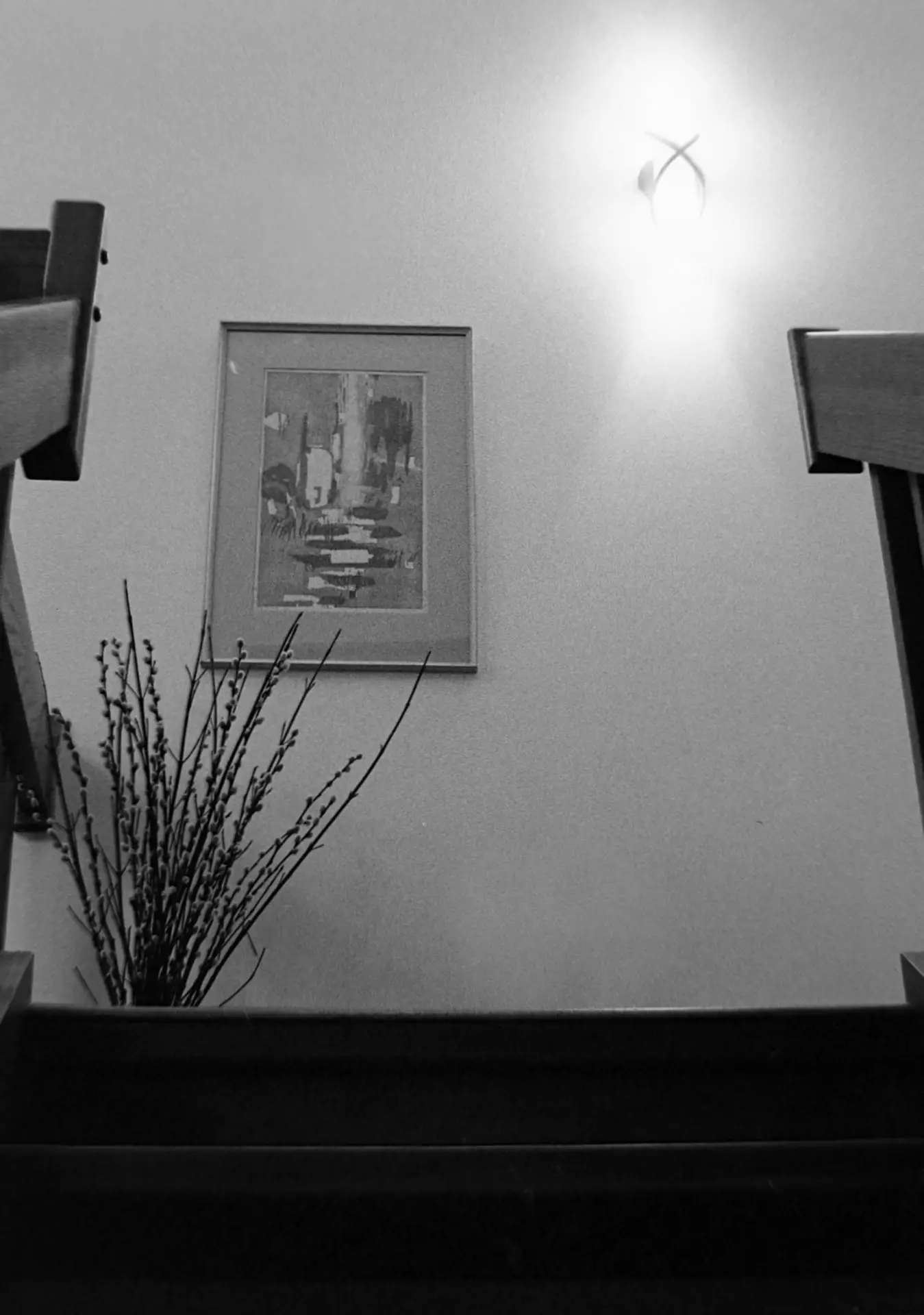
And now, Kate’s Moroccan soapstone animals parading in lamplight across a shelf (the vertical streaks behind them are wood grain):

And Finally, a Couple Landscapes
I also wanted to try daylight landscapes, and squeezed out two of ’em before the roll ended. First, our chalet flower box in early morning (focused on the vertical sunlit boards):
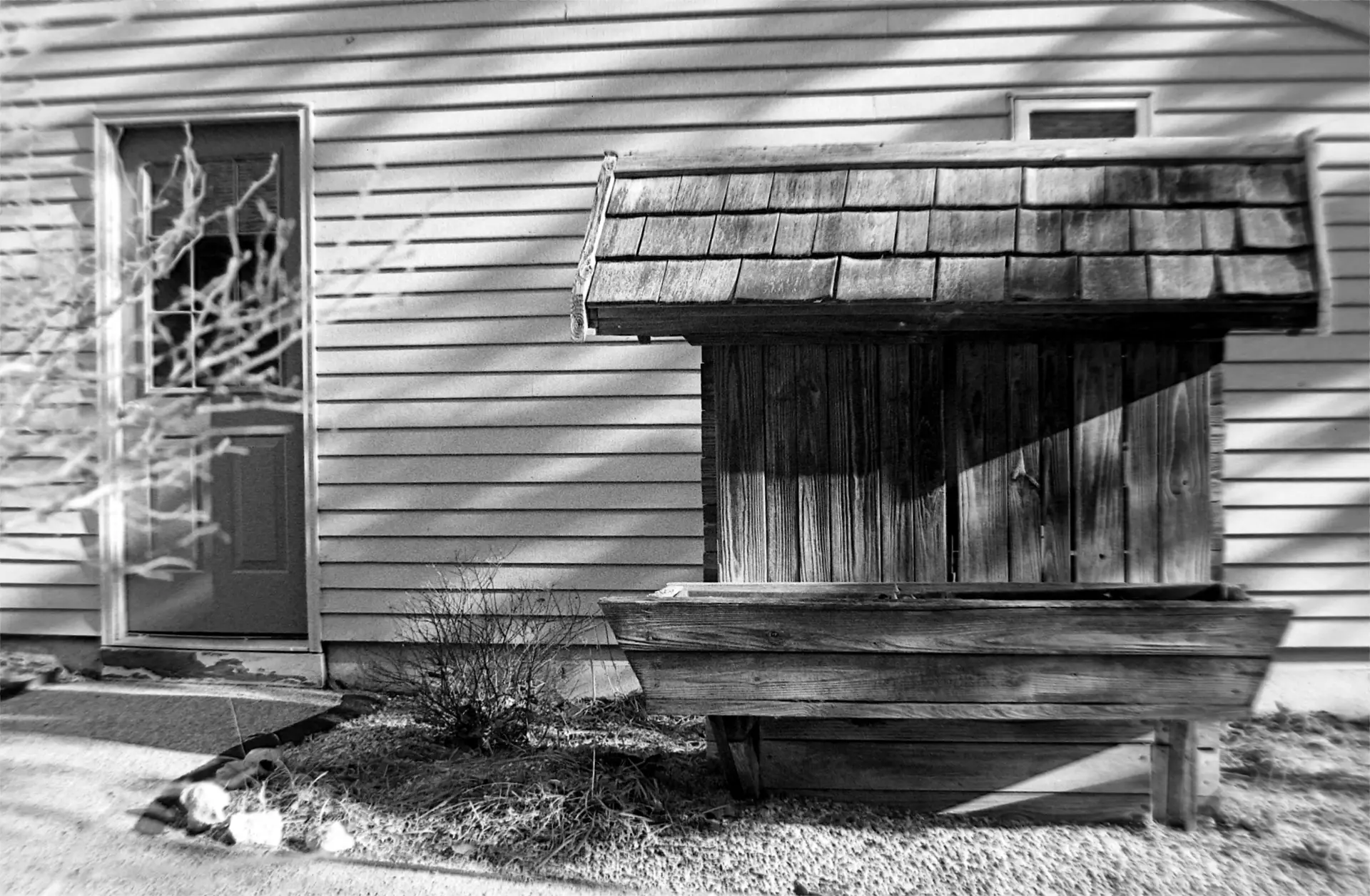
And afternoon woods and meadows behind our building (focused on the tree trunk near the center):
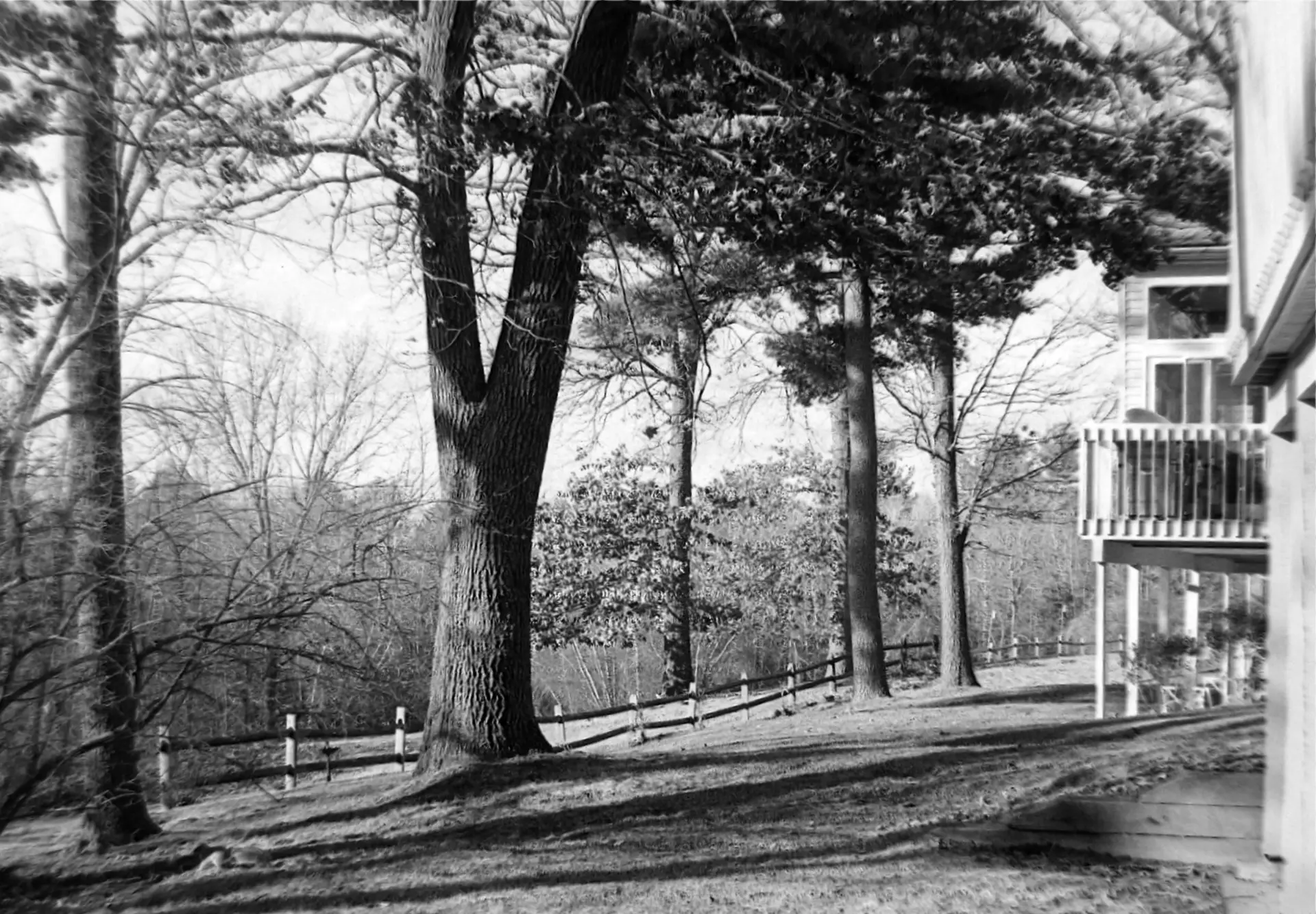
Though not shot from the same spot, that image was taken with the same film– and developed with the same Caffenol procedure– as the following (from my article about a much more advanced Contaflex Super B SLR):
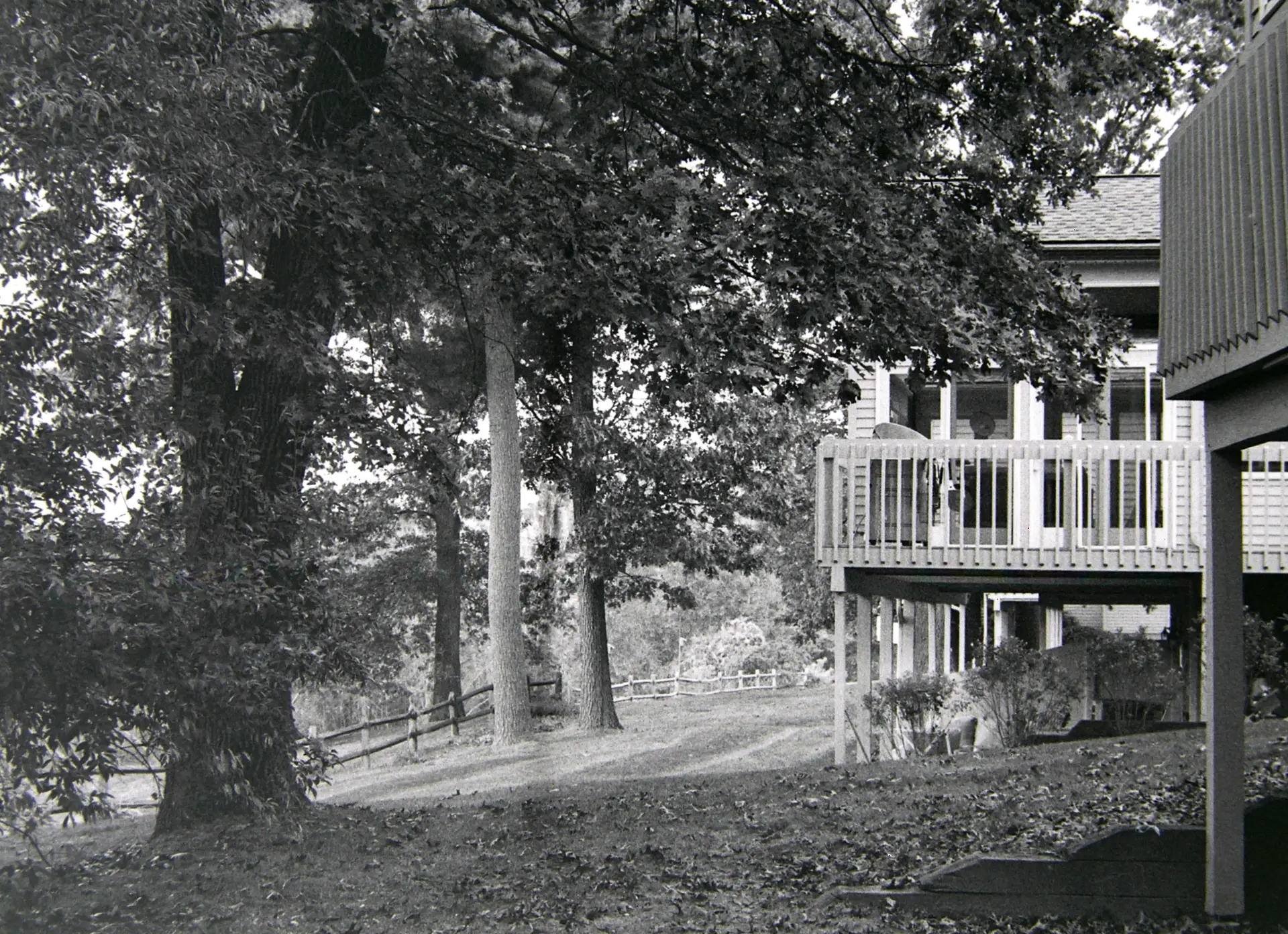 The Contaflex lens is an excellent 4-element Zeiss Tessar, while the Ansco’s is a 6-element (double-Gauss) Solagon. The only edits I made to both images were to crop out the holes along the negatives’ edges and restore grayscale tones to their full range– from pure white to pure black–using the Levels command.
The Contaflex lens is an excellent 4-element Zeiss Tessar, while the Ansco’s is a 6-element (double-Gauss) Solagon. The only edits I made to both images were to crop out the holes along the negatives’ edges and restore grayscale tones to their full range– from pure white to pure black–using the Levels command.
Both lenses are coated and the Solagon lens probably produced more-contrasty results due to brighter lighting. More notably, though, there’s correctable barrel distortion along the right side of the Solagon result (plus some edge/corner blur). But the Contaflex Tessar produced much less distortion and blur.
A Few Thoughts
As mentioned earlier, the Super Memar’s rewind knob rotates perhaps too easily in both directions. This could cause film to lose tension across the film gate and affect focus. To prevent this, I took every photo with my left thumb applying very slight leftward (clockwise) pressure on the edge of the rewind knob.
I also almost forgot to explain how this camera makes “Sunny 16” easy for me:
- With Kodak 5222 Double X film rated at 250 ASA, let’s say I set out to shoot on a very sunny afternoon. Per Sunny 16, I preset the camera to “full-sun” 1/250 @ f/16, and leave it there as long as my subjects are brightly lit. (Also note below that I could easily turn the automatically linked rings to two other equivalent exposures– 1/125 @ f/22 or 1/500 @ f/11– if desired):
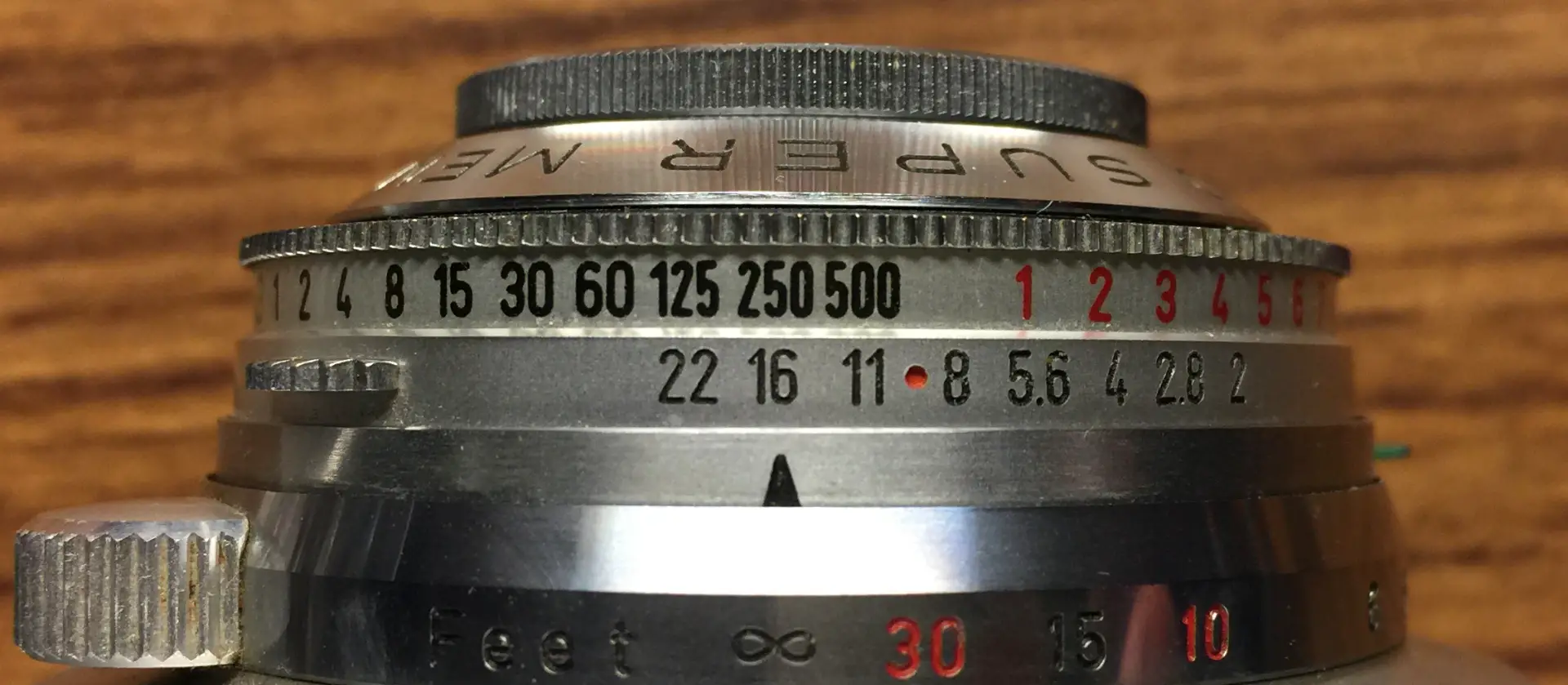
- But if some clouds move in and slightly dim the sun, I can leave the camera set to 1/250 and quickly shift the aperture ring to Sunny-16’s “cloudy-bright” f/11 (as here):
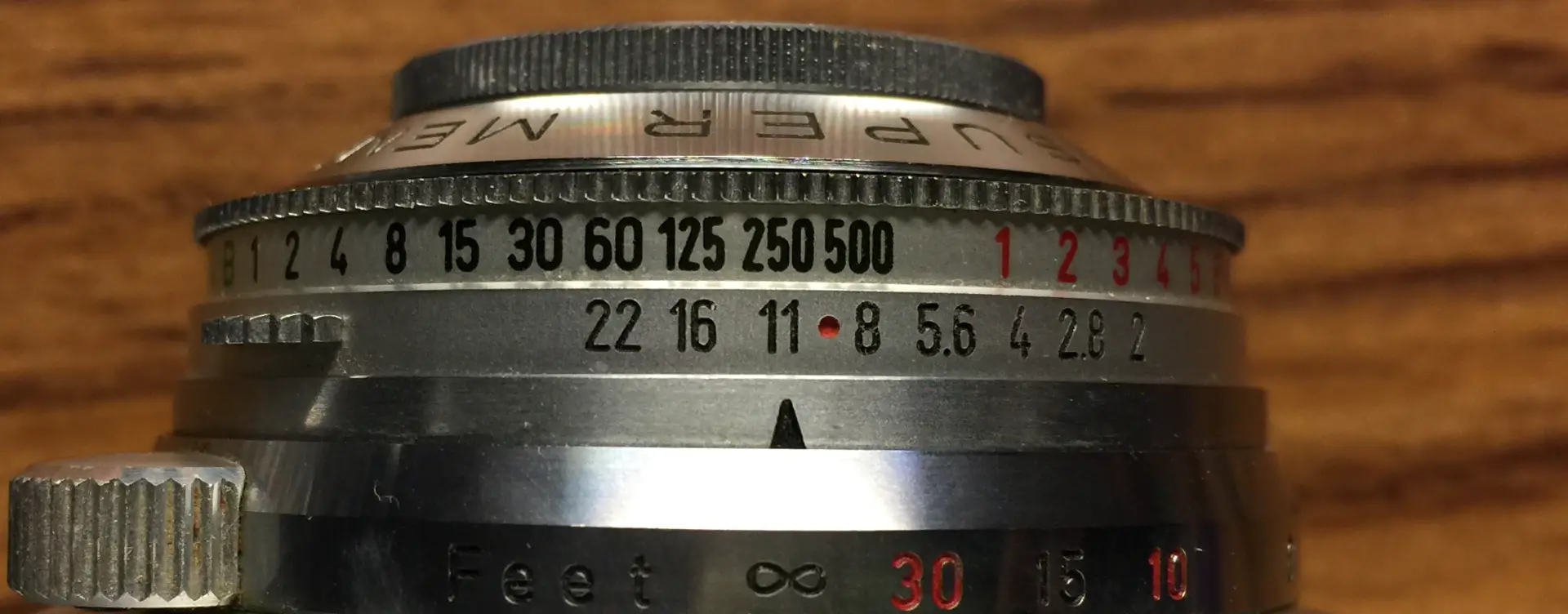
- If the clouds then pass, I can move the aperture back to “full-sun” f/16.
- Or if more clouds move in and the scene continues to dim below “cloudy-bright,” I can move to f/8. (Or return to smaller apertures as conditions brighten.)
- In practice, setting an initial condition and then adjusting apertures up and down from there makes it easy to “follow the light” through the day– without constantly referring to a Sunny-16 card or resorting to memory.
Overall, I was surprised at how well the f/2 Solagon stacked up against the justly praised Zeiss f/2.8 Tessar. The Solagon also gives slightly more reach into low-light scenes than the Tessar.
The Contaflex Super-B SLR may be superior kit, but it’s also complex and mechanically tricky. Ansco’s Super Memar, on the other hand, is simpler, perhaps more reliable, and still a high-quality device for everyday shooting. This may be why the only Super Memar that had sold on eBay as I write this went for $72. But with patient lurking, one can sometimes snag this worthy little camera for less.
SHOPPING ALERT: In online listings, I noticed a few sellers who claimed their lower-spec cameras were “Super Memars.” And while their “regular” Memars– with Agfa Apotar, Color Apotar and Solinar lenses– are also fine shooters, only the “Super” Memar has the faster Solagon lens and Synchro-Compur shutter. It’s easy to confirm the true identity of Ansco Memars in listing photos, though. The other lens bezels have a flat front… with the lens name engraved on it. But “Solagon” is enameled in white-on-black just inside the Super-Memar lens’s sharper front edge (as seen in the opening photo.)
–Dave Powell is a Westford, Mass. writer and avid amateur photographer.
Share this post:
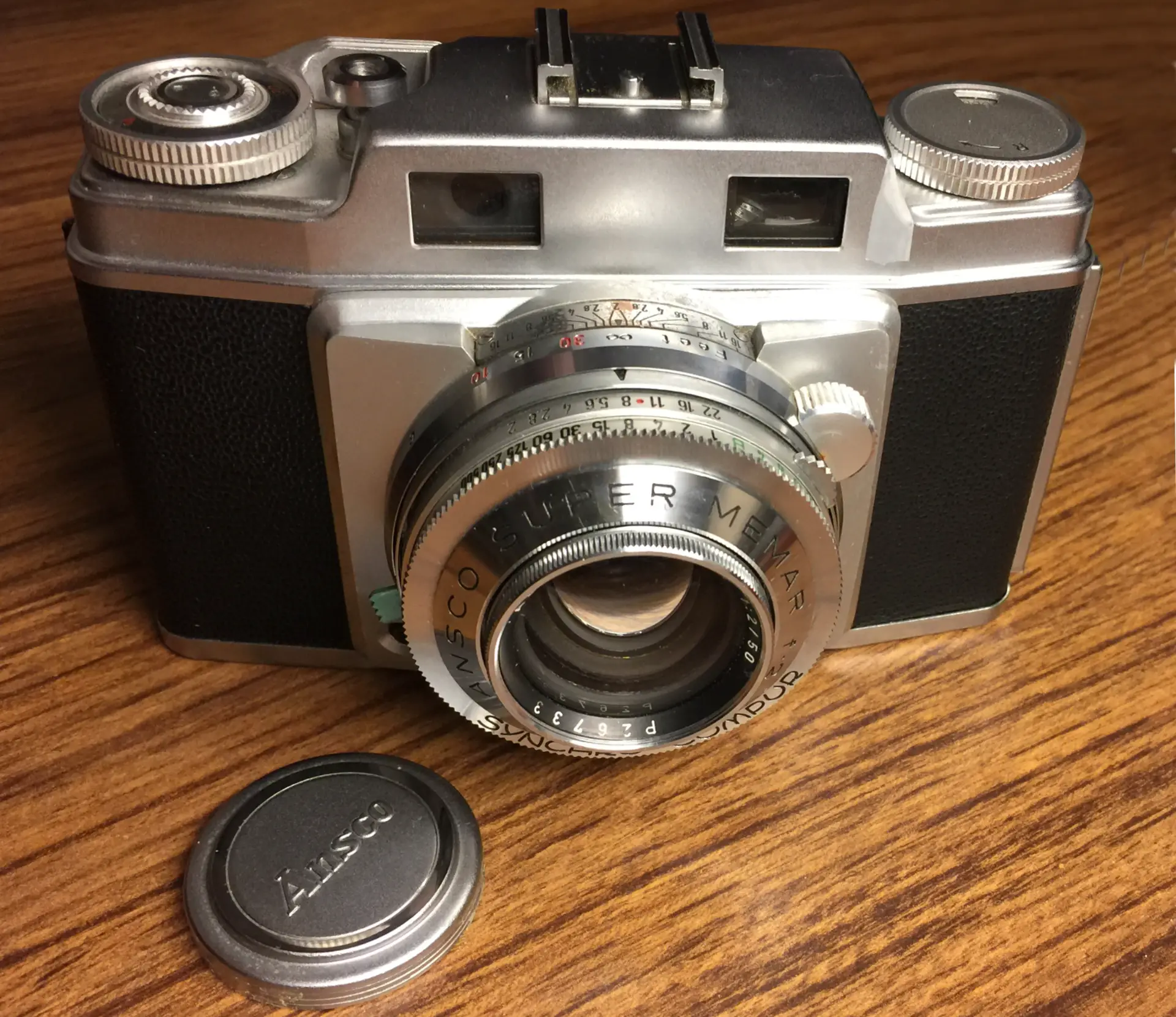
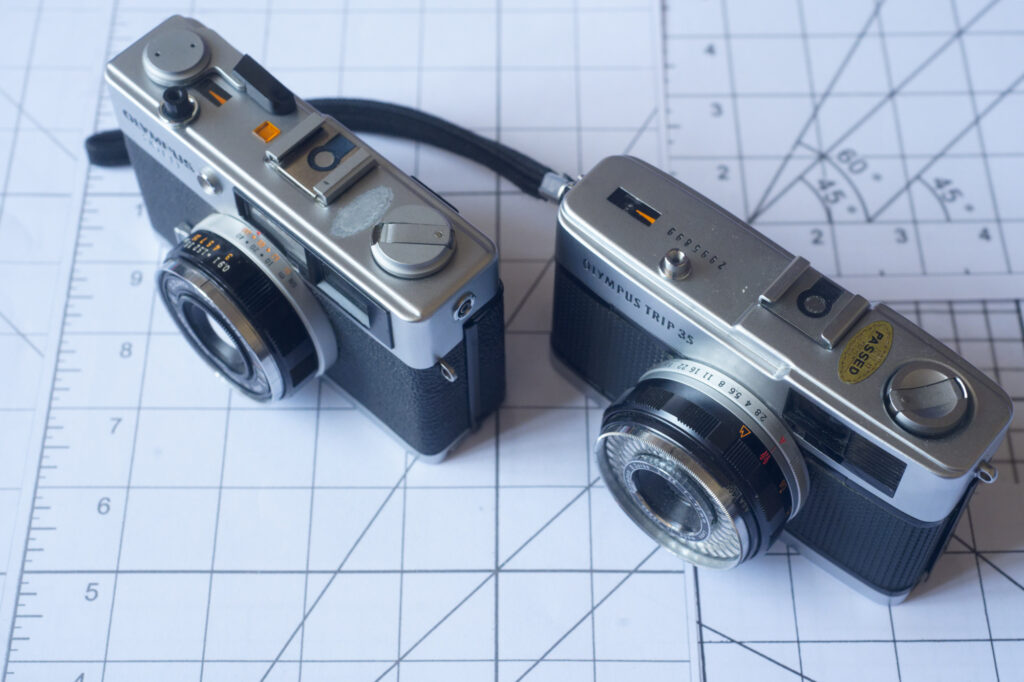


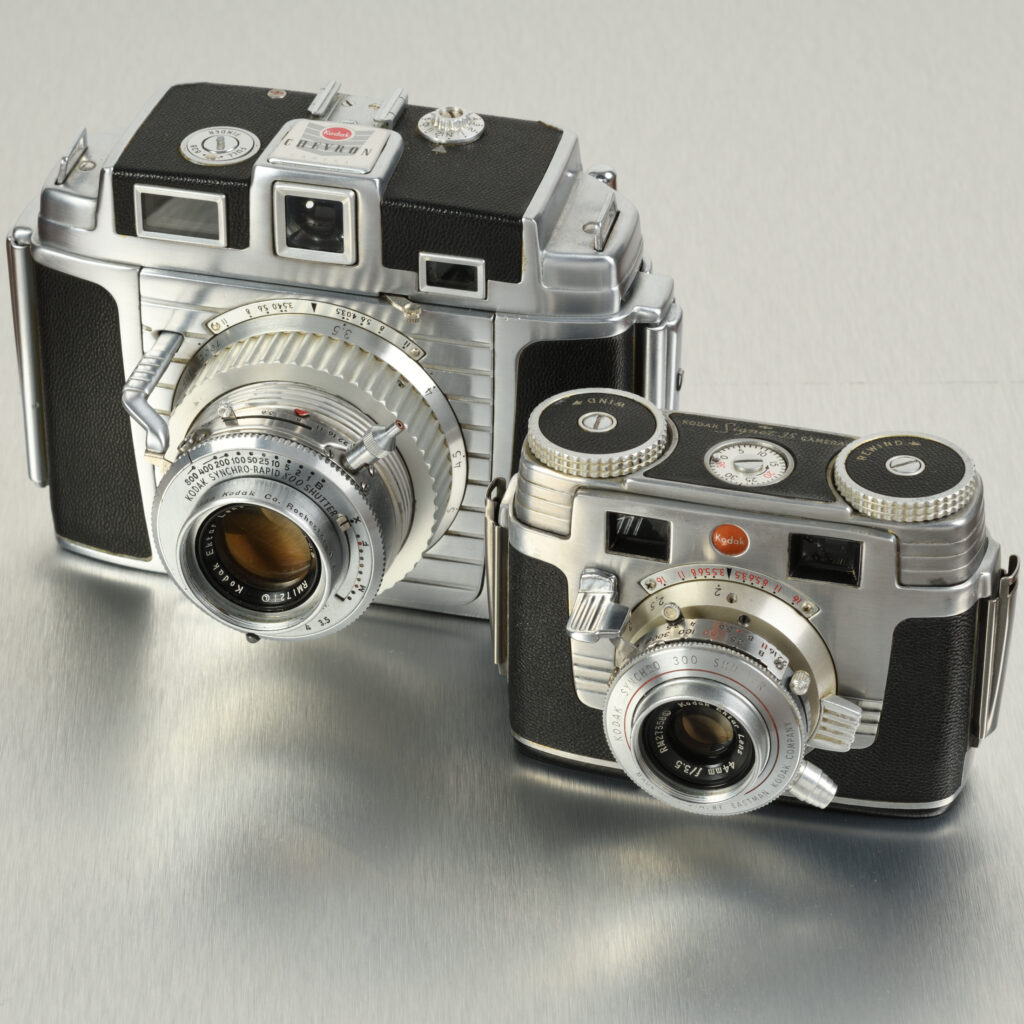




Comments
Matthew Bigwood on Ansco’s “Super Memar f/2” – A Simple High-Quality Camera
Comment posted: 26/02/2024
Comment posted: 26/02/2024
Gary Smith on Ansco’s “Super Memar f/2” – A Simple High-Quality Camera
Comment posted: 26/02/2024
Comment posted: 26/02/2024
Ibraar Hussain on Ansco’s “Super Memar f/2” – A Simple High-Quality Camera
Comment posted: 27/02/2024
Really enjoyed this and was rewarded with the lovely photographs and especially
The still life.
Thank you
Comment posted: 27/02/2024
Paul Quellin on Ansco’s “Super Memar f/2” – A Simple High-Quality Camera
Comment posted: 27/02/2024
Comment posted: 27/02/2024
Rhymer on Ansco’s “Super Memar f/2” – A Simple High-Quality Camera
Comment posted: 29/02/2024
Comment posted: 29/02/2024
Leon on Ansco’s “Super Memar f/2” – A Simple High-Quality Camera
Comment posted: 26/06/2024
Comment posted: 26/06/2024
Keith Drysdale on Ansco’s “Super Memar f/2” – A Simple High-Quality Camera
Comment posted: 01/08/2024
Comment posted: 01/08/2024